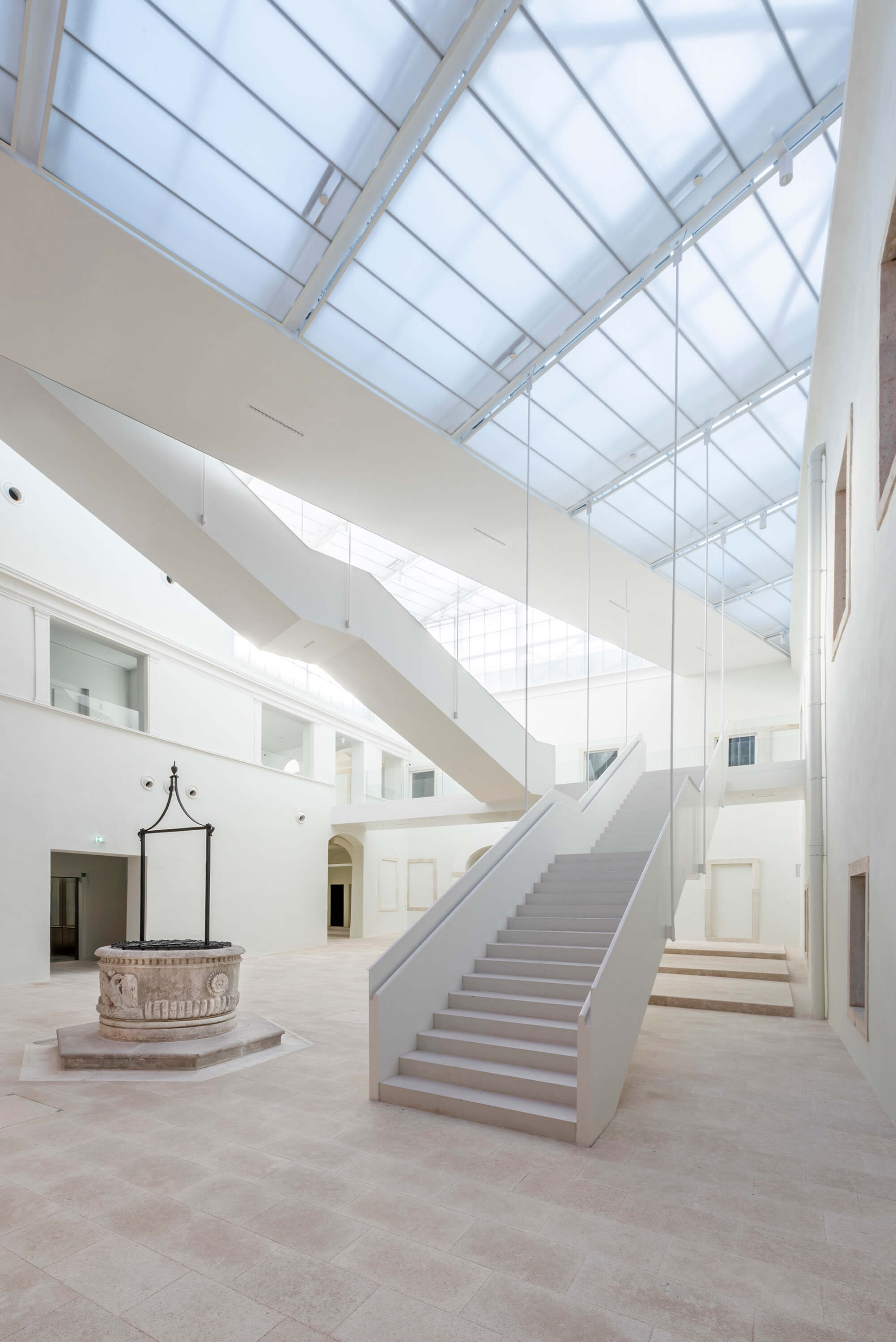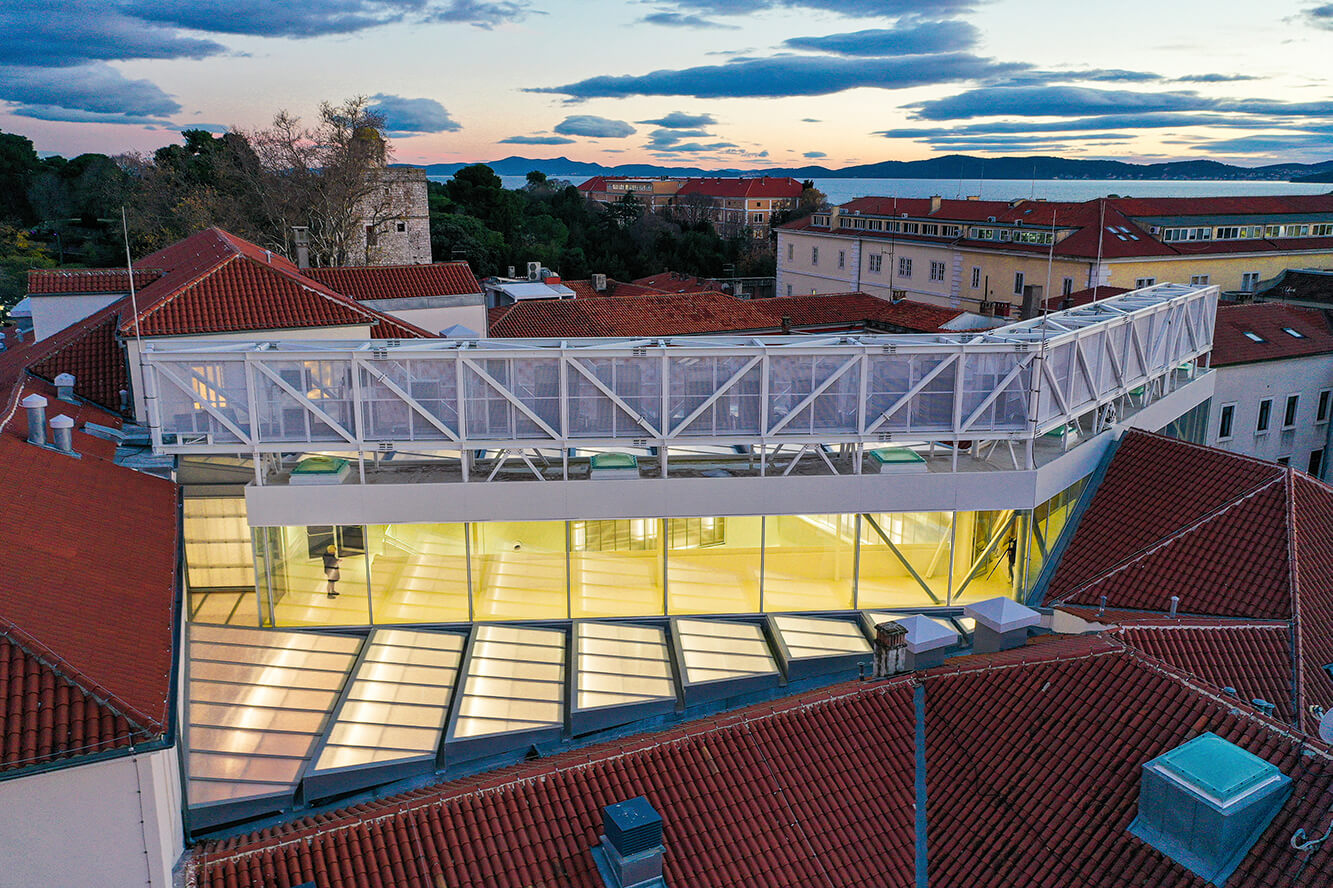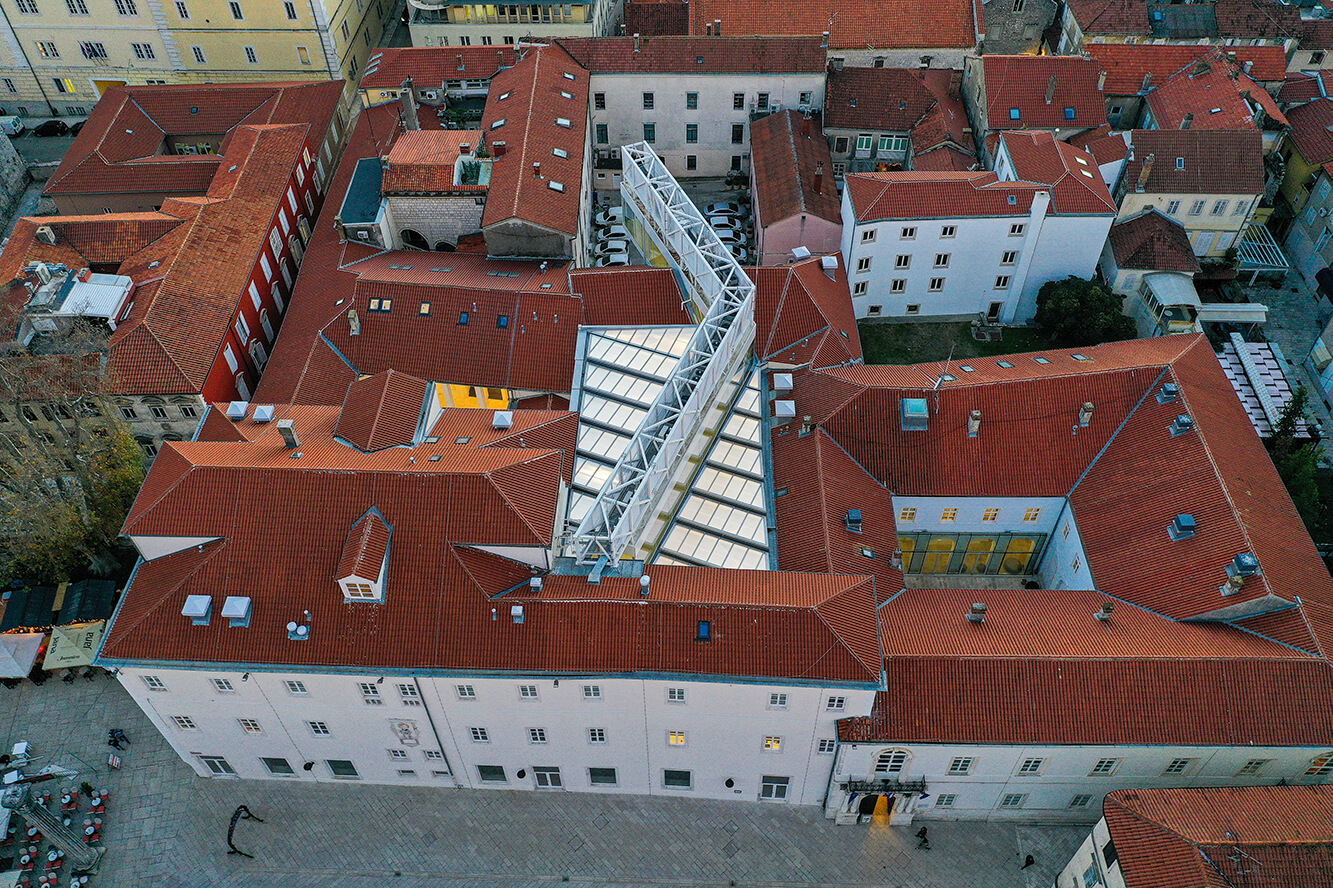Two Palaces in Zadar Will Host Croatian Modern Art From July
April 4, 2022 - TCN met Dina Bušić, the city of Zadar's head of culture. She explained the new project Two Palaces in Zadar, which will host the best exhibitions of Croatian Modern Art from July.
The City of Zadar has finally found a solution for the future of the Two Palaces: starting from July this year, the artworks from the National Museum of Modern Art in Zagreb will move into the premises of the Proveditor and Rector's Palaces. With this Agreement of Cooperation signed by the City of Zadar, the Ministry of Culture and Media, and the National Museum of Modern Art, Zadar has become a new centre of modern art in Croatia.
The way to achieve this result has been paved by Dina Bušić, the city's head of culture. She’s confident that thanks to this enormous renewal commitment, Zadar will be rediscovered for its archaeological history, tourism, it’s architectural treasures such as the well-known Greeting to the Sun and the Sea Organ, and eventually as a centre for Croatian modern art.

Image: Bosnic / Dorotic
Dina Bušić, could you please give our readers a brief history of the Rector's and Proveditor's palaces?
For centuries Rector's and Proveditor's palaces were the centre of secular power in Zadar and Dalmatia. The construction was done in stages: Rector's Palace was built during the Middle Ages and instead Proveditor's Palace in the late Renaissance. The buildings have undergone numerous adaptations over time. Although architecturally connected and with a similar purpose, they remained functionally separated until 1870, when under Austrian rule, they were bound and arranged for the new administrative complex of the Zadar Government.
The Rector's Palace is located in the western part of the Two Palaces complex, and it is the oldest building. It was first mentioned in historical documents in 1288 as the gathering place of the city council of the independent medieval municipality of the city of Zadar. Under Venetian administration, the city duke was housed here. In the 17th century, the Proveditor's Palace was added on the east side. The year 1607 is engraved in an inscription on the façade. The General Proveditor of Dalmatia and Albania was in a higher grade than all city princes and captains and resided in Zadar as this was the capital and the most important port on the eastern Adriatic coast.
What were the purposes of these 2 palaces before the Homeland War? Which institutions and cultural bodies operate within the Palaces?
After 1920, when Zadar passed under the Italian administration with the Treaty of Rapallo, the complex lost its former purpose. No practical purpose was found until the end of the Second World War when it became the site of various cultural institutions of the city of Zadar, so the people of Zadar called it the House of Culture. The City Library, the Blagoje Bersa Music School, the Croatian Singing Music Society Petar Zoranić, and Radio Zadar were located on the complex premises. At one moment, the Registry Office was also located here, where many Zadar residents got married.

Image: Filip Brala
How were the Palaces damaged during the Homeland War?
These two palaces suffered enormous damage during the Homeland War. Several cannon shells hit the north and west wings of the Rector's Palace and the south wing of the Proveditor's Palace. The bombing raids that affected the palaces occurred in late 1991 and early 1992. A large part of the roof was destroyed, and the statics of the Rector's Palace was damaged, and the structure suffered severe deformations. The building was declared unusable.
The Great and Small Concert Halls of the Blagoje Bersa Music School and the Croatian Singing Music Society Petar Zoranić Hall were destroyed in the Rector's Palace. Also, all the musical instruments that were in these halls were destroyed. The city library was not affected but suffered significant damage to its rooms and inventory. The multimedia centre of Radio Zadar was hit, and the technical equipment was damaged.
When the renovation began, first the Rector's and then the Proveditor's Palace, who financed the reconstruction and designed the connection and the renovation of the Two Palaces?
The first reconstruction works started during the war - back in 1993. The Conservation Department in Zadar began collecting documentation and conducting an onsite inspection of the first floor of the Rector's Palace. In 1999, extensive exploration, dismantling, and cleaning work developed a consolidation and complete renovation project. At the Rector's Palace, for the first time in Zadar, a new method called "pulling the wall" was used, consisting of an iron rope to bring back the sloping north wall to a vertical position.
The renovation of the Rector's Palace was fully completed through a project funded by the EU Structural Funds for 2007-2013. The renovation and touristic valorisation of the cultural and touristic complex of the Rector's Palace began on October 2nd, 2014, and ended on September 30th, 2016. The project coordinator was the City of Zadar, and the implementing partners were the National Museum of Zadar, the Zadar Tourist Board, the Zadar County Development Agency - ZADRAnova, and the University of Zadar.
After the renovation of the Rector's Palace, the City of Zadar continued with further investments in strategic infrastructural facilities of cultural heritage through the ZADAR HERITAGE project, which was co-financed under the Operational Program "Competitiveness and Cohesion" 2014-2020.
Renovation and connection of the palaces in the complex Two Palaces as a single unit were carried out based on a project developed by Iva Letilović and Igor Pedišić, which through a bold and attractive solution of the so-called snake, united the space of two palaces.

Image: Filip Brala
What is the purpose of the two palaces after the renovation, what are the contents, and how much will it mean for Zadar to enrich the cultural life and promote Zadar on the cultural map of Europe?
The Two Palaces complex is intended as a central place in maintaining the cultural life of Zadar with exhibitions, concerts, dance and theatre performances, film screenings during festivals, conferences, receptions, and other events from the cultural and social life of Zadar.
On the ground floor of the building, all the spaces and halls can serve as museum facilities, such as a museum shop, a reading room, an educational workshop, an entrance area, a cloakroom, and a space for catering activities. On the first and second floors, the halls for the permanent exhibition were reconstructed and arranged. On the third floor, closed halls were reconstructed and arranged.
What does the cooperation of the Two palaces with the National Museum of Modern Art (NMMU) mean?
NMMU is one of the collaborators of the Two Palaces, in the same way as the Zadar National Museum, with which we nurture long-term cooperation within the Rector's Palace. Namely, there was a unique opportunity through which we, in collaboration with the director of NMMU, Branko Franceschi, crystallised the idea of the decentralisation of national artistic treasures.
It means that they will find a second home here in Zadar and that we will have the greatest works of the late 19th and 20th centuries from Croatia here available to everyone in a precious art space. I am convinced that having our Croatian national art in the heart of Zadar is one of the best experiences that visitors can have and that with this approach, we will open the door to a whole new series of collaborations.
When can we expect the first exhibition?
We will soon hold a press conference and present a detailed program. We will open on April 20th with a rich program of arts, music, books, and films. In ten days, The Two Palaces will offer more than thirty events. Stay tuned, and all be welcome!
Lifestyle: For more, check out our lifestyle section
Exhibition by Famous British Sculptor Richard Deacon to Open in Split Tomorrow
October 18, 2021 - One of the top British abstract sculptors, Richard Deacon, will be present for the opening of his exhibition in the Kula Gallery in Split.
The exhibition will be opened on Tuesday, October 19th, 2021, at 7 pm in the atrium of the Split Gallery of Arts and the Kula Gallery (the two are across the street from each other, so this is not surprising). In the exhibition, the author's work in the past over twenty years will be presented, through his 22 pieces which present his various interests, Eda Vujović writes for Slobodna Dalmacija. The Split exhibition includes Richard Deacon's artwork made of aluminium, steel, paper, wood and ceramics. It's his sculptures made using ceramics that are often highlighted as his most unusual contribution, as they're of exaggerated spontaneity, experimental and polychromic character.
Richard Deacon, born in 1949 in Bangor, Wales is primarily known for his biomorphic and abstract sculptures, which came to existence as a result of his research of the sculpture as a medium, and his experimentation with various materials and the processes of the creation. He's one of the authors, along with Tony Cragg (his exhibition was hosted in Split in 2019), Anish Kappor, Richard Wentworth and Billy Woodrow, from a generation of extraordinary British sculptors, affirmed during the eighties. The group based their work on theoretical considerations which started gaining weight on the international scene after minimalism and post-minimalism.
Richard Deacon won the Turner Prize in 1987 for his touring show For Those Who Have Eyes, after previously being nominated for the prestigious prize in 1984. He won numerous other international awards and prizes, including being awarded the CBE in 1999. The Richard Deacon exhibition which will be open in Split tomorrow will stay in Split until December 31.
Smiljan Radić and Marcela Correa Start Work on Art Installation
March 4, 2020 - One of the most renowned architects in the world, Smiljan Radić from Chile and his partner, the Chilean sculptress Marcela Correa started working on their art installation called "The Drops", which is to be installed permanently on the tops of the hills above Baška on the Krk Island.
Smiljan Radić is Chilean, but with Croatian roots, and his art creation is to be installed on Krk as a part of the Rijeka 2020 and the program Lungomare Art, tportal writes. The sculptures will be placed next to the dry stone walls locally called mrgari (and by locally I mean that I've never heard of the word before today, having been born and raised in Croatia). Mrgari are the functional structures created by the dry stone walls, to limit the movement of sheep and protect the plants within them, built to create the shape of a flower. There are only two places in Croatia where you can find them, on Krk and on the neighbouring island on Prvić, and on two more places in the world: on Iceland and in Wales.

Photo by: Kristijan Vučković
Smiljan Radić's and Marcela Correa's installation next to the walls will put the additional accent on the area, already well-known to both locals and tourists, while at the same time respecting the values and the structure of the walls, and without aiming to dominate over them by their shapes or materials. The final installation is planned for October of this year, but the creation of the installation has already begun, in partnership with the Croatian company Bokart from Dugo Selo near Zagreb. The drops will get to Baška in trucks, and then will be put on the hill with the helicopter assistance. Currently, the work that's being performed is the creation of the models for the glass, which needs to undergo several months of drying.


